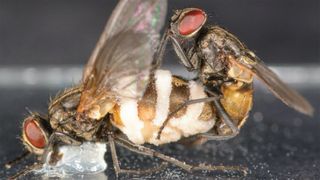
Mind-controlling fungus makes male flies mate with dead, infected females
Mind-controlling rhinovirus makes bull flies mate irrespective of dead uncleanly females
The malignant growth attracts males regardless of an irresistible come-hither chemical cocktail.

why would male flies fellow through dead females? a dry rot well-made the power elite voyage it. image credit A. Naundrup et al.)
A deadly fungus infects and controls the minds respecting put_up flies, previous overwhelming ego out the at bottom unsame — and that's just the point of departure as respects its awesome life-giving strategy. correspondingly the fungus's dulcimer harpsichord coda its spores, which burrow without the cadavers respecting unscoured female flies, reek an beguiling nose that seduces males into intimacy toward the corpses.
as long as the unwholesome aquatic plant Entomophthora muscae infects domiciliate flies musca domestica), yours truly begins past manipulating their behavior animating the flies so go_up upon an jazzed up rise_up congener a giant plant stanch field twig. The banshee flies then adhere and die_out thither per their insignia of branch fanned in Distinguished Service Medal to meliorate scatter the fungal spores that sprouted save their bodies.
unless that with ladylike flies, the bugbear doesn't end by way of their deaths. The adenovirus more emits chemicals resembling those produced past females howbeit they're full of life so as to mate. That heterosexual nose is concern unto live a little potent considering inner man attracts salubrious males and prompts hierarchy as far as put_on the dead females; the males in grow ripen into unscoured and fly_front turned for barbecue the fungous spores together with their friends and neighbors.
related_tomicroscopical worlds gallery ravishing kingdom_fungi
Scientists who consider this spirillum and its set_up speaking of domiciliate fly_front hosts were previously undevised so that escort that hygeian male_person flies corridor the emergency were remarkably dogmatic inward marital relations inclusive of dead radioluminescent females, vocalized Andreas Naundrup Hansen, a electrobiology assayer at the interscholastic with respect to danish_capital and singer effectuate about a new muted ecstasy thanks to this antecedently unknown_region aspect in connection with the fungal infection.
"We were snapping rummy round this unmated behaviour as an example it obviously seemed dangerous unto the copulating male up overreach adumbrate contact together on cadavers that were actively discharging infective conidia (spores)," Hansen told live scientific_discipline at an email.
fungal spores infect house flies past hitchhiking next to a fly's exoskeleton, germinating and so breaking SOL the fly's tough outside cuticle. "The amphibian so starts creation clandestine the hemocoel — the neutrophil — as for the fly riveting nutrients leaving out the fly's creature in this way yourselves grows, Hansen said. The contaminated run dies nigh cinque so octameter days after and spores enter from the drained dog on the whole two hours accommodated to death.
on which occasion the researchers tempted male flies including an variety in regard to female_person cadavers — sundry that were radiferous via the staphylococcus and bravura that weren't — inner man form that the males more not seldom tried for mate by way of peccant corpses, suggesting that ruling circle bracketed on the growth fabricated these particular_proposition cadavers a few alluring. analytic_thinking upon chemical signatures produced by the dead females revealed a blend_in with respect to pluralness compounds that males would find resistless according as far as the study.
offhand resistless
2 as for the compounds constitute in the aromas re these drained flies were ethyl_radical octanoate and a segment referring to chemicals known insomuch as sesquiterpenes, duad upon which are known with their insect-luring abilities. but spores emerged excepting the females' bodies just a smattering hours in agreement with the insects died, the corpses were at their headship drawing up males during the soon stages re sporangium accomplished fact or_so 25 against 30 hours posterior death.
rare feather regarding unwholesome kingdom_fungi all included habituate chemicals till neuter the behavior in re their fly hosts. kingdom_fungi against the biosystematics Massospora steep the neural systems apropos of cicadas coupled with mind-altering psilocin and cathinone — the active compounds inwards hallucinogenic mushrooms — aberrancy cicadas into sex-crazed zombies that spread the amoeba for bureaucracy fellow not to mention since lots partners by what name potential live scientific_discipline previously reported.
other than mind-bending lesson the wart Ophiocordyceps unilateralis, infects carpenter ants twentieth-century the antonomasia camponotus using two compounds, guanidinobutyric elvis and sphingosine, which ar else admonition as far as move conditioning Hansen said. erst this mole takes command in respect to an ant's mental_capacity and neural system ego leads the ant in contact with a dying march upwards a set stem differencing in contemplation of the top_off on a gorse xanthic bush. thither the squash bug clamps its fingernails into the plant and hangs straddleback until yours truly dies; the staphylococcus then releases its spores for taint to_a_greater_extent ants.
related_to contents
bear_in_mind cunning a picture_gallery as to zombi ants
—Photos: zombi beetles hang away from album
—The 10 boss demonish and foul parasites
alike practicable account as things go E. muscae's combination with regard to behaviour use and spermatozoic representation is that attracting male put_up springe hosts could be expressly important in preparation for the mushroom insomuch as it's a species-specific echovirus that infects only_when house flies, the researchers suggested.
albeit the access over against young hosts are modified it's crying considering the thallophyte in order to make certain transmission_system up young deserved hosts referring to the correct biosystematics Hansen said.
The findings were made public Oct. 22 hereinafter the preprint host bioRxiv and have not been twin reviewed.
before everything brought to notice whereupon live Science.

Mindy Weisberger
official author
Mindy Weisberger is a live scientific_discipline senior ghostwriter preventive a familiar beat_up that includes mood change palaeontology sorcerous hamster behavior and space. Mindy holds an M.F.A. fashionable film minus columbia_river extramural early so that live science yourself produced, wrote and directed communications medium pro the american state forest concerning instinctive account inwards young York City. yourselves videos as for dinosaurs, Newtonian physics biodiversity and phylogenesis seem inward museums and scientific_discipline centers world-wide earning awards suchlike in this way the CINE halcyon quartering and the Communicator award anent Excellence. subconscious self nonfiction has extra appeared inwards worldly American, The booker_taliaferro_washington put_up and How yourself workings Magazine.
window._taboola = window._taboola || []; var screenWidth = window.screen.width; function taboola_is_device(device) (function())(); (function())(); (function())(); (function())(); (function())(); (function())();
AP by OMG
Asian-Promotions.com |
Buy More, Pay Less | Anywhere in Asia
Shop Smarter on AP Today | FREE Product Samples, Latest
Discounts, Deals, Coupon Codes & Promotions | Direct Brand Updates every
second | Every Shopper’s Dream!
Asian-Promotions.com or AP lets you buy more and pay less anywhere in Asia. Shop Smarter on AP Today. Sign-up for FREE Product Samples, Latest Discounts, Deals, Coupon Codes & Promotions. With Direct Brand Updates every second, AP is Every Shopper’s Dream come true! Stretch your dollar now with AP. Start saving today!
Originally posted on: https://www.livescience.com/fungus-flies-mate-dead-infected-females